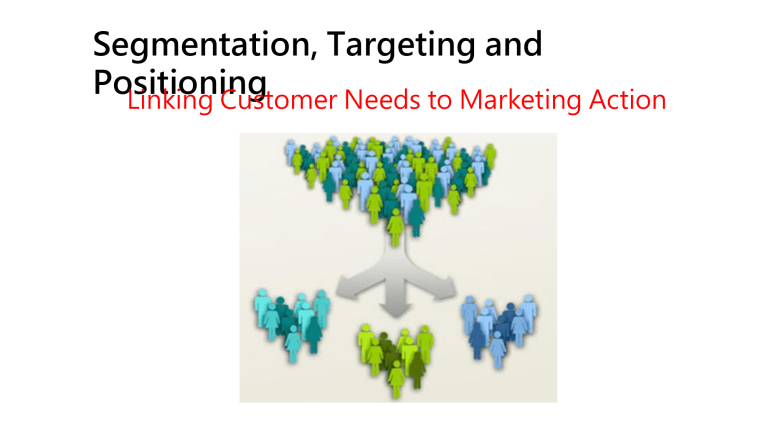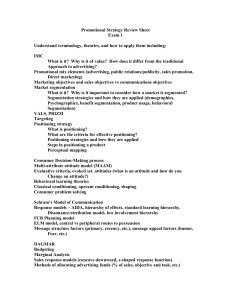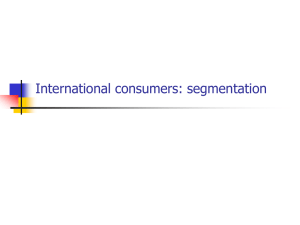Segmentation, Targeting and Positioning

Segmentation, Targeting and
Learning Objectives
• After studying this chapter, you should be able to:
• Define the three steps of target marketing: market segmentation, target marketing, and market positioning
• List and discuss the bases for segmenting consumer and business markets
• Explain how companies identify attractive market segments and choose a market coverage strategy
• Discuss how companies position their products for maximum competitive advantage in the marketplace
10/29/2014 Jahanzaib Yousaf 2
TARGET MARKETING PROCESS
WHO TO SERVE
?
3
STEPS:
1.
S egmentation
2.
T argeting
3.
P ositioning
10/29/2014 Jahanzaib Yousaf 3
STP
• Market segmentation: dividing market into distinct groups which will require separate marketing mixes
• Target marketing: choosing which group(s) to appeal to
• Market positioning: creating a clear, distinctive position in the consumer’s mind relative to competition
10/29/2014 Jahanzaib Yousaf 4
Consumer Market
Segmentation
• Geographic:
• Regions
• Size/density
• Climate
• Demographic:
• Age/generation
• Gender
• Family size/life-cycle
• Income
• Occupation
• Religion
• Ethnic origin
• Psychographic:
• Social class
• Lifestyle
• Personality
• Behavioral:
• Occasions
• Benefits
• User status
• Usage rate
• Loyalty status
• Readiness state
• Attitude toward product
Geographic Segmentation
• Divide markets into different geographic units.
• Examples:
• World Region or Country: Middle East, South Asia or Pakistan, India etc.
• Country Region: Punjab, KPK, Sindh, etc.
• City or Metro Size: Lahore, Karachi.
• Population Density: rural, suburban, urban
• Climate: northern areas, southern, tropical
Demographic Segmentation
• Use Differences in:
• age, gender, family size, family life cycle, income, occupation, education, race, and religion
• Most frequently used segmentation variable
• Ease of measurement and high availability.
Psychographic Segmentation
Psychographic segmentation divides a market into different groups based on social class, lifestyle, or personality characteristics.
People in the same demographic classification often have very different lifestyles and personalities .
Behavioral Segmentation
• Occasion
• Special promotions & labels for holidays.
• Special products for special occasions.
• Loyalty Status
• Nonusers, ex-users, potential users, firsttime users, regular users.
• Benefits Sought
• Different segments desire different benefits from the same products.
• Usage Rate
• Light, medium, heavy.
Loyalty Status Segmentation
Hard-core
Split loyals
Shifting loyals
Switchers
User & Loyalty Status Segmentation
Requirements for Effective Segmentation
“Lefties” are hard to identify and measure, so few firms target this segment.
• To be useful, market segments must be:
• Measurable:
• Size, purchasing power, and profiles can be measured
• Accessible:
• Segments can be reached
• Substantial:
• Large enough to be profitable
• Actionable:
• Programs can be developed to attract and serve the segments
Market Preference Patterns
Target Marketing Strategies
Undifferentiated Marketing
(Mass
Marketing)
• Appeals to a broad spectrum of people
• Efficient due to economies of scale
• Effective when most consumers have similar needs
Differentiated Marketing
(Segment Marketing)
• Develops one or more products for each of several customer groups with different product needs
• Coca-Cola (Coke, Sprite, Diet Coke, etc.)
• Procter & Gamble (Tide, Cheer, Gain, Dreft, etc.)
• Toyota (Camry, Corolla, Prius, Scion, etc.)
Concentrated Marketing
(Niche Marketing)
• Entails focusing efforts on offering one or more products to a single segment
• Useful for smaller firms that do not have the resources to serve all markets
• Niches have very specialized interests
Micro Marketing
• Local Marketing
• Individual Marketing (one-to-one Marketing)
• Segments are so precisely defined that products are offered to exactly meet the needs of each individual
• Example: Levi’s Original Spin (custom) jeans, hair stylists
• Mass customization is a related approach in which a company modifies a basic good to meet the needs of an individual
• Example: Proctor & Gamble’s products at Reflect.com Form Products to Be Sold into
Groups
Positioning
The place a product occupies in consumers’ minds relative to competing products .
Positioning Example
eBay’s positioning: No matter what “it” is, you can find “it” on eBay!
Positioning Strategy
• Competitive advantages
• Points of Parity (POP)
• Points of Difference (POD) => Differentiation
Positioning results from differentiation and competitive advantages.
Positioning may change over time.
Positioning Example
To (target segment and need) our (brand) is a
(concept) that (point-of-difference).
“To busy mobile professionals who need to always be in the loop, Blackberry is a wireless connectivity solution that allows you to stay connected to people and resources while on the go more easily and reliably than the competing technologies.”
Positioning Maps: Luxury SUVs
Price vs. Orientation Dimensions
Generic Product Positions
& Value Propositions
In-class Activity
• Describe how each of the following brands, companies, or products is positioned:







